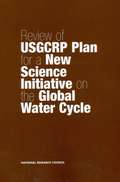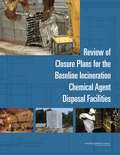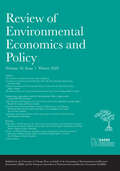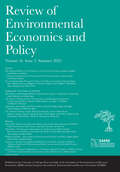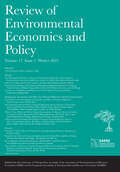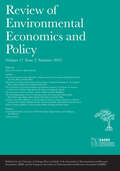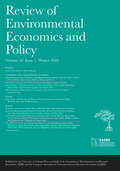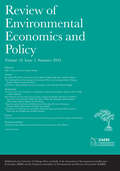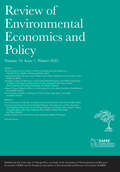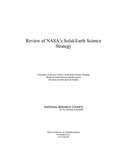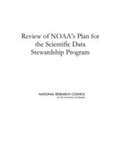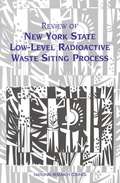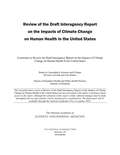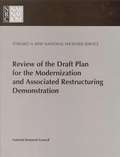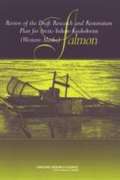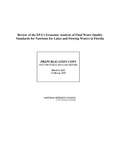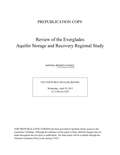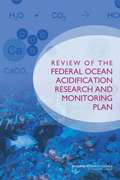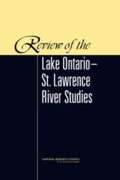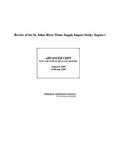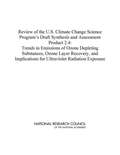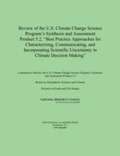- Table View
- List View
Review Of Usgcrp Plan For A New Science Initiative On The Global Water Cycle
by Committee on a Review of A Plan for a New Science Initiative on the Global Water CycleA Review Of Usgcrp Plan For A New Science Initiative On The Global Water Cycle
Review Procedures for Water Resources Project Planning
by National Research CouncilA Review Procedures For Water Resources Project Planning
Review of Closure Plans for the Baseline Incineration Chemical Agent Disposal Facilities
by National Research Council of the National AcademiesThis book responds to a request by the director of the U.S. Army Chemical Materials Agency (CMA) for the National Research Council to examine and evaluate the ongoing planning for closure of the four currently operational baseline incineration chemical agent disposal facilities and the closure of a related testing facility. The book evaluates the closure planning process as well as some aspects of closure operations that are taking place while the facilities are still disposing of agent. These facilities are located in Anniston, Alabama; Pine Bluff, Arkansas; Tooele, Utah; and Umatilla, Oregon. They are designated by the acronyms ANCDF, PBCDF, TOCDF, and UMCDF, respectively. Although the facilities all use the same technology and are in many ways identical, each has a particular set of challenges.
Review of Environmental Economics and Policy, volume 16 number 1 (Winter 2022)
by Review of Environmental Economics and PolicyThis is volume 16 issue 1 of Review of Environmental Economics and Policy. The Review of Environmental Economics and Policy (REEP) is an official journal of the Association of Environmental and Resource Economists and the European Association of Environmental and Resource Economists. REEP publishes symposia, articles, and regular features that contribute to one or more of the following goals: to identify and synthesize lessons learned from recent and ongoing environmental economics research; to provide economic analysis of environmental policy issues; to promote the sharing of ideas and perspectives among the various sub-fields of environmental economics; to strengthen the linkages between environmental economics research and environmental policy; to encourage communication and connections between academics and the wider policy community; to offer suggestions for future research; to provide insights and readings for use in the classroom; to address issues of interest to the environmental economics profession.
Review of Environmental Economics and Policy, volume 16 number 2 (Summer 2022)
by Review of Environmental Economics and PolicyThis is volume 16 issue 2 of Review of Environmental Economics and Policy. The Review of Environmental Economics and Policy (REEP) is an official journal of the Association of Environmental and Resource Economists and the European Association of Environmental and Resource Economists. REEP publishes symposia, articles, and regular features that contribute to one or more of the following goals: to identify and synthesize lessons learned from recent and ongoing environmental economics research; to provide economic analysis of environmental policy issues; to promote the sharing of ideas and perspectives among the various sub-fields of environmental economics; to strengthen the linkages between environmental economics research and environmental policy; to encourage communication and connections between academics and the wider policy community; to offer suggestions for future research; to provide insights and readings for use in the classroom; to address issues of interest to the environmental economics profession.
Review of Environmental Economics and Policy, volume 17 number 1 (Winter 2023)
by Review of Environmental Economics and PolicyThis is volume 17 issue 1 of Review of Environmental Economics and Policy. The Review of Environmental Economics and Policy (REEP) is an official journal of the Association of Environmental and Resource Economists and the European Association of Environmental and Resource Economists. REEP publishes symposia, articles, and regular features that contribute to one or more of the following goals: to identify and synthesize lessons learned from recent and ongoing environmental economics research; to provide economic analysis of environmental policy issues; to promote the sharing of ideas and perspectives among the various sub-fields of environmental economics; to strengthen the linkages between environmental economics research and environmental policy; to encourage communication and connections between academics and the wider policy community; to offer suggestions for future research; to provide insights and readings for use in the classroom; to address issues of interest to the environmental economics profession.
Review of Environmental Economics and Policy, volume 17 number 2 (Summer 2023)
by Review of Environmental Economics and PolicyThis is volume 17 issue 2 of Review of Environmental Economics and Policy. The Review of Environmental Economics and Policy (REEP) is an official journal of the Association of Environmental and Resource Economists and the European Association of Environmental and Resource Economists. REEP publishes symposia, articles, and regular features that contribute to one or more of the following goals: to identify and synthesize lessons learned from recent and ongoing environmental economics research; to provide economic analysis of environmental policy issues; to promote the sharing of ideas and perspectives among the various sub-fields of environmental economics; to strengthen the linkages between environmental economics research and environmental policy; to encourage communication and connections between academics and the wider policy community; to offer suggestions for future research; to provide insights and readings for use in the classroom; to address issues of interest to the environmental economics profession.
Review of Environmental Economics and Policy, volume 18 number 1 (Winter 2024)
by Review of Environmental Economics and PolicyThis is volume 18 issue 1 of Review of Environmental Economics and Policy. The Review of Environmental Economics and Policy (REEP) is an official journal of the Association of Environmental and Resource Economists and the European Association of Environmental and Resource Economists. REEP publishes symposia, articles, and regular features that contribute to one or more of the following goals: to identify and synthesize lessons learned from recent and ongoing environmental economics research; to provide economic analysis of environmental policy issues; to promote the sharing of ideas and perspectives among the various sub-fields of environmental economics; to strengthen the linkages between environmental economics research and environmental policy; to encourage communication and connections between academics and the wider policy community; to offer suggestions for future research; to provide insights and readings for use in the classroom; to address issues of interest to the environmental economics profession.
Review of Environmental Economics and Policy, volume 18 number 2 (Summer 2024)
by Review of Environmental Economics and PolicyThis is volume 18 issue 2 of Review of Environmental Economics and Policy. The Review of Environmental Economics and Policy (REEP) is an official journal of the Association of Environmental and Resource Economists and the European Association of Environmental and Resource Economists. REEP publishes symposia, articles, and regular features that contribute to one or more of the following goals: to identify and synthesize lessons learned from recent and ongoing environmental economics research; to provide economic analysis of environmental policy issues; to promote the sharing of ideas and perspectives among the various sub-fields of environmental economics; to strengthen the linkages between environmental economics research and environmental policy; to encourage communication and connections between academics and the wider policy community; to offer suggestions for future research; to provide insights and readings for use in the classroom; to address issues of interest to the environmental economics profession.
Review of Environmental Economics and Policy, volume 19 number 1 (Winter 2025)
by Review of Environmental Economics and PolicyThis is volume 19 issue 1 of Review of Environmental Economics and Policy. The Review of Environmental Economics and Policy (REEP) is an official journal of the Association of Environmental and Resource Economists and the European Association of Environmental and Resource Economists. REEP publishes symposia, articles, and regular features that contribute to one or more of the following goals: to identify and synthesize lessons learned from recent and ongoing environmental economics research; to provide economic analysis of environmental policy issues; to promote the sharing of ideas and perspectives among the various sub-fields of environmental economics; to strengthen the linkages between environmental economics research and environmental policy; to encourage communication and connections between academics and the wider policy community; to offer suggestions for future research; to provide insights and readings for use in the classroom; to address issues of interest to the environmental economics profession.
Review of NASA's Solid-Earth Science Strategy
by Committee to Review NASA's Solid-Earth Science StrategyThe report reviews NASA's solid-earth science strategy, placing particular emphasis on observational strategies for measuring surface deformation, high-resolution topography, surface properties, and the variability of the earth's magnetic and gravity fields. The report found that NASA is uniquely positioned to implement these observational strategies and that a number of agency programs would benefit from the resulting data. In particular, the report strongly endorses the near-term launch of a satellite dedicated to L-band InSAR measurements of the land surface, which is a key component of the U. S. Geological Survey's hazards mitigation program and the multi-agency EarthScope program.
Review of NOAA's Plan for the Scientific Data Stewardship Program
by National Research Council of the National AcademiesTo better understand our climate system, it is important that we have climate data records (CDRs)--time series of measurements of sufficient length, consistency, and continuity to determine climate variability and change--that possess the accuracy, longevity, and stability to facilitate credible climate monitoring. In 2004, the National Research Council (NRC) published Climate Data Records from Environmental Satellites to provide the National Oceanic and Atmospheric Administration (NOAA) with initial guidelines on how to develop and implement an effective CDR program. NOAA used this book to draft a plan for a new Scientific Data Stewardship (SDS) program, and then asked NRC to review it. The new program will be responsible for processing, archiving, and distributing observations from satellite and supporting ground-based platforms for monitoring, diagnosing, understanding, predicting, modeling, and assessing climate variation and change. The NRC review outlines several ways in which to improve NOAA's draft plan, most importantly by clarifying advisory mechanisms, providing more detail about how NOAA will coordinate with important partners in generating CDRs, articulating how the program will prioritize its activities, and developing ways to realistically project future costs. However, the draft plan is sound overall and NOAA should immediately begin implementing the SDS program while revising the plan as recommended in the book.
Review of New York State Low-Level Radioactive Waste Siting Process
by Committee to Review New York State's Siting Methodology Selection for Low-Level Radioactive Waste DisposalThis book reviews the efforts of New York state to site a low-level radioactive waste disposal facility. It evaluates the nature, sources, and quality of the data, analyses, and procedures used by the New York State Siting Commission in its decisionmaking process, which identified five potential sites for low-level waste disposal. Finally, the committee offers a chapter highlighting the lessons in siting low-level radioactive waste facilities that can be learned from New York State's experience.
Review of Proposals to the Bureau of Land Management on Wild Horse and Burro Sterilization or Contraception: A Letter Report
by Committee for the Review of Proposals to the Bureau of Land Management on Wild Horse Burro Sterilization or ContraceptionAs a follow-up to the 2013 report Using Science to Improve the Wild Horse and Burro Program: A Way Forward, this letter report reviews research project proposals submitted to the Bureau of Land Management and aimed at developing new or refining existing techniques and establishing protocols for the contraception or permanent sterilization of either male or female wild horses and/or burros in the field. Review of Proposals to the Bureau of Land Management on Wild Horse and Burro Sterilization or Contraception considers factors related to the scientific validity of the proposed technique(s), goals and objectives of the work, research methodology and design of the study, proposed statistical analysis and interpretation of anticipated data obtained, animal welfare implications and Institutional Animal Care and Use Committee approvals, feasibility, as well as the qualifications, expertise, and experience of the investigators. This report ranks the proposals in order of merit and provides a brief report on additional factors for the Bureau of Land Management to consider in selecting proposals to fund.
Review of the Draft Interagency Report on the Impacts of Climate Change on Human Health in the United States
by Engineering Medicine National Academies of ScienceThe U.S. National Climate Assessment (NCA; Melillo et al., 2014) identified a number of ways in which climate change is affecting or is likely to affect, people, infrastructure, natural resources, and ecosystems. Those impacts in turn have the potential for important current and future consequences for human health. Research on these impacts is active, with strong evidence to support some aspects and research still in progress for others. Therefore, there is a need to assess our understanding of how the impacts of climate change on the environment can create stressors that can affect human health in a number of dimensions both now and in the future. <P> In response to this need, the U.S. Global Change Research Program (USGCRP) has initiated an interagency Assessment on the Impacts of Climate Change on Human Health in the United States. The Assessment is intended to inform public health authorities, other planning and policy entities, and the general public. It extends the work begun under the 2008 Synthesis and Assessment Product 4.6 (USGCRP, 2008) Analyses of the Effects of Global Change on Human Health and Welfare and Human Systems and the third NCA released in 2014.
Review of the Draft Plan for the Modernization and Associated Restructuring Demonstration
by National Weather Service Modernization CommitteeThe National Academies Press (NAP)--publisher for the National Academies--publishes more than 200 books a year offering the most authoritative views, definitive information, and groundbreaking recommendations on a wide range of topics in science, engineering, and health. Our books are unique in that they are authored by the nation's leading experts in every scientific field.
Review of the Draft Research and Restoration Plan for Arctic-Yukon-Kuskokwim (Western Alaska) Salmon
by National Research Council of the National AcademiesDeclines in the abundance of salmon in the Arctic-Yukon-Kuskokwim (AYK) region of western Alaska in the late 1990s and early 2000s created hardships for the people and communities who depend on this resource. Based on recommendations from a 2004 National Academies report, the AYK Sustainable Salmon Initiative (SSI) developed a research and restoration plan to help understand the reasons for this decline and to help support sustainable management in the region. This report reviews the draft plan, recommending some clarification, shortening, and other improvements, with a better focus on the relationship between the underlying intellectual model and the research questions, and a clearer discussion of local and traditional knowledge and capacity building.
Review of the EPA's Economic Analysis of Final Water Quality Standards for Lakes and Flowing Waters in Florida
by Committee to Review EPA's Economic Analysis of Final Water Quality Standards for Nutrients for Lakes Flowing Waters in FloridaThe Environmental Protection Agency's estimate of the costs associated with implementing numeric nutrient criteria in Florida's waterways was significantly lower than many stakeholders expected. This discrepancy was due, in part, to the fact that the Environmental Protection Agency's analysis considered only the incremental cost of reducing nutrients in waters it considered "newly impaired" as a result of the new criteria-not the total cost of improving water quality in Florida. The incremental approach is appropriate for this type of assessment, but the Environmental Protection Agency's cost analysis would have been more accurate if it better described the differences between the new numeric criteria rule and the narrative rule it would replace, and how the differences affect the costs of implementing nutrient reductions over time, instead of at a fixed time point. Such an analysis would have more accurately described which pollutant sources, for example municipal wastewater treatment plants or agricultural operations, would bear the costs over time under the different rules and would have better illuminated the uncertainties in making such cost estimates.
Review of the Everglades Aquifer Storage and Recovery Regional Study
by Committee to Review the Florida Aquifer Storage Recover Regional Study Technical Data ReportThe Florida Everglades is a large and diverse aquatic ecosystem that has been greatly altered over the past century by an extensive water control infrastructure designed to increase agricultural and urban economic productivity. The Comprehensive Everglades Restoration Plan (CERP), launched in 2000, is a joint effort led by the state and federal government to reverse the decline of the ecosystem. Increasing water storage is a critical component of the restoration, and the CERP included projects that would drill over 330 aquifer storage and recovery (ASR) wells to store up to 1. 65 billion gallons per day in porous and permeable units in the aquifer system during wet periods for recovery during seasonal or longer-term dry periods. To address uncertainties regarding regional effects of large-scale ASR implementation in the Everglades, the U. S. Army Corps of Engineers (USACE) and the South Florida Water Management District conducted an 11-year ASR Regional Study, with focus on the hydrogeology of the Floridan aquifer system, water quality changes during aquifer storage, possible ecological risks posed by recovered water, and the regional capacity for ASR implementation. At the request of the USACE, "Review of the Everglades Aquifer Storage and Recovery Regional Study" reviews the ASR Regional Study Technical Data Report and assesses progress in reducing uncertainties related to full-scale CERP ASR implementation. This report considers the validity of the data collection and interpretation methods; integration of studies; evaluation of scaling from pilot-to regional-scale application of ASR; and the adequacy and reliability of the study as a basis for future applications of ASR.
Review of the Federal Ocean Acidification Research and Monitoring Plan
by National Research Council Ocean Studies Board Division on Earth and Life Studies Committee on the Review of the National Ocean Acidification Research and Monitoring PlanThe world's ocean has already experienced a 30% rise in acidity since the industrial revolution, with acidity expected to rise 100 to 150% over preindustrial levels by the end of this century. Potential consequences to marine life and also to economic activities that depend on a healthy marine ecosystem are difficult to assess and predict, but potentially devastating. To address this knowledge gap, Congress passed the Federal Ocean Acidification Research and Monitoring (FOARAM) Act in 2009, which, among other things, required that an interagency working group create a "Strategic Plan for Federal Research and Monitoring of Ocean Acidification." Review of the Federal Ocean Acidification Research and Monitoring Plan reviews the strategic plan on the basis of how well it fulfills program elements laid out in the FOARAM Act and follows the advice provided to the working group in the NRC's 2010 report, Ocean Acidification: A National Strategy to Meet the Challenges of a Changing Ocean. This report concludes that, overall, the plan is strong and provides a comprehensive framework for improving our understanding of ocean acidification. Potential improvements include a better defined strategy for implementing program goals, stronger integration of the seven broad scientific themes laid out in the FOARAM Act, and better mechanisms for coordination among federal agencies and with other U.S. and international efforts to address ocean acidification.
Review of the Lake Ontario-St. Lawrence River Studies
by National Research Council of the National AcademiesSince the 1950s,the International Joint Commission (IJC) of Canada and the United States has issued water regulation and management plans for Lake Ontario and the St. Lawrence River. Changes in recreational, environmental, navigational and other uses of the water system have prompted the IJC to consider replacing the current water regulation plan in operation for more than 40 years. IJC’s goals for a replacement plan include sound scientific foundations, public participation, transparency in plan development and evaluation, and inclusion of environmental considerations. To help develop and select the new plan, the IJC supported a 5-year, $20 million Lake Ontario-St. Lawrence River Study (LOSLR Study). The LOSLR Study uses models to compile and integrate data gathered from a series of commissioned studies of wetlands, species at risk, recreational boating, fisheries, coastal erosion and flooding, commercial navigation, hydropower, industrial, municipal and domestic water intakes, public information and education, and hydrologic modeling. This report reviews a portion of the study that focused on wetlands and species at risk and three of the models that were used. The report finds that the overall breadth of the LOSLR study is impressive, and commends the scale and inclusiveness of the studies and models. In terms of informing decision making, however, the reviewed studies and models show deficiencies when evaluated against ten evaluation criteria, including treatment of uncertainty, quality control/quality assurance, thorough documentation, and empirical foundations. Among the report’s recommendations is a need for more thorough documentation of study methods and findings, stronger and more consistent quality control, and more attention to how uncertainty should be addressed to better inform decision making. This NRC study was conducted in collaboration with the Royal Society of Canada.
Review of the St. Johns River Water Supply Impact Study: Report 1
by National Research Council of the National AcademiesThe St. Johns River is the longest river in Florida, containing extensive freshwater wetlands, numerous large lakes, a wide estuarine channel, and a correspondingly diverse array of native flora and fauna. Water resource management in the river's watershed is the responsibility of the St. Johns River Water Management District (the District). The District must provide water for the region's 4.4 million residents as well as numerous industrial and agricultural users, all while protecting natural systems within the river basin. With population growth in the watershed expected to surpass 7.2 million in 2030, the District, through its water resources planning process, has begun to identify alternative sources of water beyond its traditional groundwater sources, including the potential withdrawal of 262 million gallons per day from the St. Johns River. To more comprehensively evaluate the environmental impacts of withdrawing this water from the river, the District embarked on a two-year Water Supply Impact Study (WSIS), and requested the involvement of the National Research Council. The present volume reviews the Phase I work of the WSIS and provides recommendations for improving Phase II.
Review of the U.S. Climate Change Science Program's Draft Synthesis and Assessment Product 2.4: Trends in Emissions of Ozone Depleting Substances, Ozone Layer Recovery, and Implications for Ultraviolet Radiation Exposure
by National Research Council of the National AcademiesThe U.S. Climate Change Science Program is in the process of producing 21 draft assessments that investigate changes in the Earth's climate and related systems. These assessments are designed to inform decisionmakers about the scientific underpinnings of a range of environmental issues, such as stratospheric ozone. This National Research Council report reviews one of these assessments, Synthesis and Assessment Product (SAP) 2.4, Trends in Emissions of Ozone Depletion Substances, Ozone Layer Recovery, and Implications for Ultraviolet Radiation Exposure. This assessment is noted as being the first-ever attempt to look at the United States contribution to ozone-depleting substances and ozone recovery. This National Research Council book commends the assessment's authoring team for comprehensively covering the scientific basis of ozone and ozone-depleting substances, but recommends several ways that the assessment could be improved. Suggestions include clarifying the discussion on climate effects of ozone and revising the approach to estimating U.S. contributions to production, consumption, and emission of ozone-depleting substances. The assessment could also be improved by reorganizing and editing to accommodate intended audiences.
Review of the U.S. Climate Change Science Program's Synthesis and Assessment Product 5.2, "Best Practice Approaches for Characterizing, Communicating, and Incorporating Scientific Uncertainty in Climate Decision Making"
by National Research Council of the National AcademiesThis report reviews the U.S. Climate Change Science Program’s new draft assessment product on characterizing and communicating uncertainty information for climate change decision making, one of 21 climate change assessment products that the program is developing to meet the requirements of the 1990 Global Change Research Act. Although the draft assessment is effective in discussing methods of characterizing uncertainty, it falls short in several ways. It is written for researchers involved in assessment efforts and will likely be of use to them, but does not address other key audiences, particularly policymakers, decision-makers, and members of the media and general public. In addition, it does not assess the full range of "best practice approaches" for characterizing, incorporating, and communicating uncertainty. These weaknesses were due in part to a change in the prospectus after the process had begun to include new target audiences and a different scope of work. It will take a substantial revision of the current draft or production of a companion document, both requiring additional authors, to address these issues.
Review of the U.S. Climate Change Science Program's Synthesis and Assessment Product on Temperature Trends in the Lower Atmosphere
by National Research Council of the National AcademiesThe U.S. Climate Change Science Program (CCSP), established in 2002 to coordinate climate and global change research conducted in the United States and to support decision-making on climate-related issues, is producing twenty-one synthesis and assessment reports that address its research, observation, and decision-support needs. The first report, produced by the National Oceanic and Atmospheric Administration (NOAA) in coordination with other agencies, focuses on understanding reported differences between independently produced data sets of temperature trends for the surface through the lower stratosphere and comparing these data sets to model simulations. To ensure credibility and quality, NOAA asked the National Research Council to conduct an independent review of the report. The committee concluded that the report Temperature Trends in the Lower Atmosphere: Understanding and Reconciling Differences is a good first draft that covers an appropriate range of issues, but that it could be strengthened in a number of ways.
